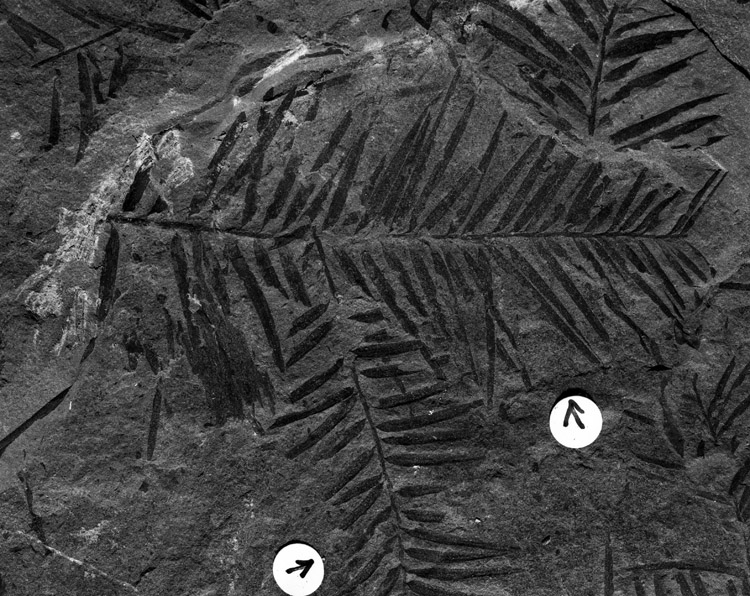Locality
Locality 11556, along the Yukon River, was particularly rich in plant remains. It yielded a variety of forms and had the largest number of forms in common with other localities. The richness of the assemblages may, in part, be because the matrix varies in grain size. While the sediment is predominantly a calcareous iron-rich claystone, coarser siltstones yielding the larger platanoid forms (HAPLTL29 and HAPLD27) are found. Even the finer-grained sediments often exhibit signs of being rapidly deposited because bedding of both the inorganic matrix and the plant remains is frequently poor. Single blocks of matrix 0.3 m or so in diameter show a range of bedding development from finely laminated fine-grained sediment to coarser siltstone which has no discernible bedding, and which yields poorly sorted plant debris entombed at various orientations with respect to the laminated sediments.
Unfortunately the sediments cannot be studied in situ as all of the specimens were collected from slumped material at the foot of the slide indicated by Martin in Hollick (1930, Fig. 4, p. 24). The localities are restricted to the river bank and dense vegetation prevented any investigation of possible exposures up the small valley which Martin in Hollick (1930) suggests was the source of the material. Although not in place, the suite of fossils is considered to represent a single assemblage because characteristics of deposition and lithology, except grain size, are more or less the same between the different specimen-yielding blocks.
Hollick (1930) was also of the opinion that his collections from this area (Lots 2962, 3252 and 3536) represented the same assemblages. Furthermore he recognized that ferns and gymnosperms were more abundant here and suggested that the collections represented a "" *** horizon slightly older than any of the others, or *** an environmental phase of the same period of deposition (Hollick, 1930, p. 3).
Locality 11556 is interpreted as representing a body of relatively quiet water perhaps not directly connected to the main river channel but which was subject to periodic innudation by flood waters. It therefore predominantly reflects the backswamp community and the platanoid hamamelid-like leaf forms were either growing immediately around this depositional site or were washed or blown in from very close by. The fact that platanoid leaves occur at this locality cannot be interpreted as necessarily meaning they were transported to the site from elsewhere. It would be surprising if the facies associations were mutually exclusive as species separations between river margin and backswamp communities are not absolute even in floodplain environments today, and some species overlap might well have occurred in the Cretaceous communities.
The mixed nature of locality 11556 provides the key for understanding the contemporaneous nature of the assemblages laid down in the swamp/lacustrine and fluvial environments, because it allows the relative ages of the various localities to be compared. Of the eleven forms found in more than one locality, six are platanoid hamamelid-like leaves, one is an RAPE leaf, one a gymnosperm, one a fern, and two are magnoliid-like leaves. These tie localities 11550, 11551, 11552, 11554, 11556, 11559, 11561, 11571 and 11572 together suggesting that they are probably all of approximately the same age.
Description
Leafy shoots: leaves varying in shape from narrow elliptical near shoot apex to linear lanceolate; leaf apex obtuse to rounded angular acute; base rounded decurrent with a small footstalk running obliquely for a short distance along shoot axis, a dark band approximately a quater of the width of the leaf runs centrally along the length of the leaf in a groove; leaf arrangement close near the apex becoming more widely spaced below, phyllotaxy obscure, distichous appearing to be sub-opposite in older shoots.
Remarks
Hollick's (1930, 1936) treatment of the Alaskan fossil coniferous shoots is confused (Seward, 1935; Chaney, 1951) particularly regarding the genus Cephalotaxopsis to which he would probably have assigned these specimens. Chaney considered that most or all of Hollick's material referred to C. heterophylla Holick and C. intermedia was assignable to Torreya as many of the needles show opposite attachment and the needles are too narrowly distally to resemble those of Metasequoia, and should be placed under Hollick's Tumion (Torreya) gracillimum. Chaney further suggested that the foliage Hollick assigned to C. microphylla var. laxa Hollick might also belong to this species but some specimens may represent Taxodium. He hoped additional material would resolve these problems. Krassilov (1979) included Cephalotaxopsis intermedia in the species Parataxodium intermedium (Hollick) Krassilov.
The absence of reproductive material and lack of cuticular features must render any determinations unreliable. The inevitable confusion is compounded in that leaves on these foliage shoots exhibit considerable variation in shape, size, density, and angle of attachment to the shoot. This variation could reflect shoot maturityl or position within the crown or a combination of these factors.
The larger specimens (USGS 11556.94, USHS 11556.41 and USGS 11556.19) have leaves similar in shape to the lower ones of form GCO80. All have acute tips, a narrow ovate shape, a medial longitudinal groove and possess a pronounced foot-stalk. The insertion on the shoot axis is the same, being apparently sub-opposite to alternate but in reality probably reflecting a distichous helical phyllotaxy. the shoots were probably abscissed as complete units and specimen USGS 11556.94 exhibits a pronounced reduction of leaf size towards its base. Such a feature is seen in a specimen of Hollick's assigned to C. heterophylla (USNM 37393; Hollick 1930, Plate 15, Fig. 10). The 'rigidity' of the foliage, a character frequently used by Hollick to distinguish forms, is invalid taxonomically because some specimens (USGS11556.19 and USGS 11556.94) possess both straight and curved leaves.
